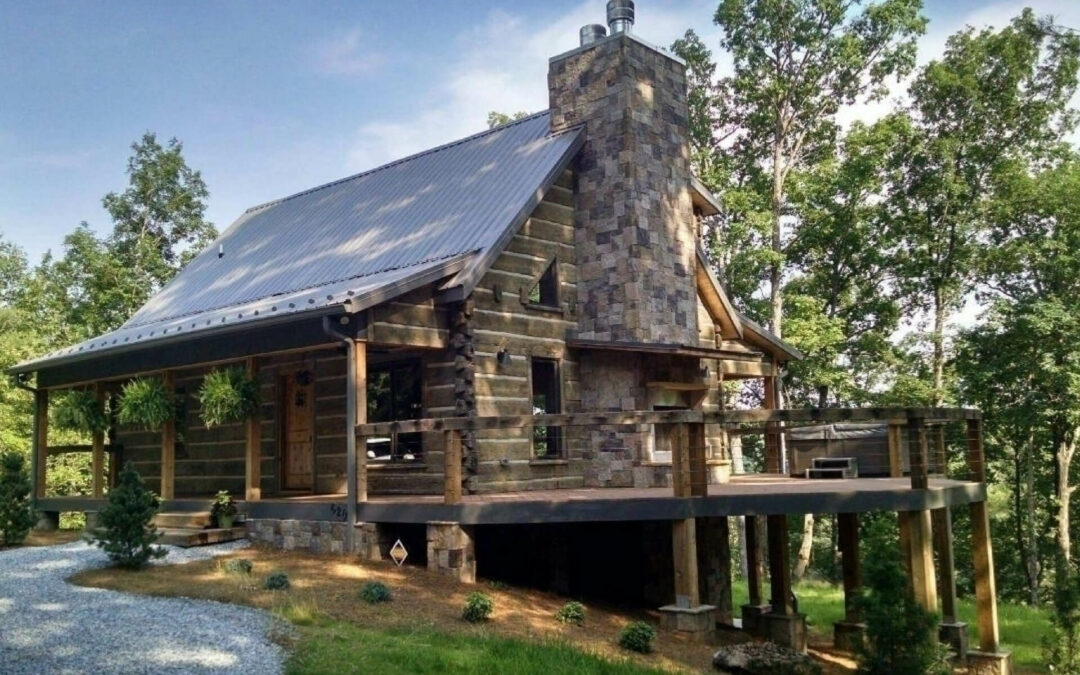Log cabin style siding is a popular choice for homeowners who want to add a touch of rustic charm to their homes. With its distinctive appearance and weather-resistant qualities, log cabin siding can enhance the overall look and feel of any home. In this article, we will explore the different options available for log cabin style siding in Cary, and discuss the various materials used, installation process, and maintenance tips.
Understanding Log Cabin Style Siding
Before delving into the specifics, it is important to understand what log cabin style siding is and why it is so appealing to homeowners. Log cabin siding is designed to mimic the look of traditional log cabins, with horizontal planks that have the appearance of stacked logs. This type of siding gives homes a warm, rustic feel and blends seamlessly with natural surroundings.
The Appeal of Log Cabin Siding
One of the main reasons homeowners choose log cabin style siding is because of its unique aesthetic appeal. The natural look and texture of the siding can instantly transform a plain house into a cozy cabin retreat. Log cabin siding also brings a sense of history and tradition, making it a timeless choice for both traditional and contemporary homes.
Besides its visual appeal, log cabin siding offers several practical benefits. It is durable and long-lasting, capable of withstanding harsh weather conditions. The planks are treated to be resistant to rot, decay, and insect damage, ensuring that the siding remains in excellent condition for years to come.
Key Characteristics of Log Cabin Siding
Log cabin style siding has several key characteristics that set it apart from other siding options. The first is its unique profile, which gives the appearance of stacked logs. This creates a distinct visual effect that adds depth and texture to the exterior of a home.
Another characteristic is the wide range of available sizes and profiles. Homeowners can choose from full log siding, half log siding, or quarter log siding, depending on their desired look and budget. Full log siding provides the most authentic log cabin look, while half and quarter log siding offer a more economical option.
Types of Log Cabin Style Siding
When it comes to log cabin style siding, there are several options to choose from. Each type has its own distinct features and advantages, allowing homeowners to select the one that best suits their preferences and needs.
Full Log Siding
Full log siding is the most authentic option, as it consists of whole logs that are precisely cut and shaped to create the appearance of a solid log wall. This type of siding provides maximum insulation and durability, making it a popular choice for those looking for an authentic log cabin experience.
The installation process for full log siding can be more complex and time-consuming compared to other types. Each log needs to be carefully fitted together and sealed to prevent any moisture penetration. However, the end result is a beautiful, natural-looking exterior that is both structurally sound and visually stunning.
Half Log Siding
Half log siding, as the name suggests, is created by attaching half-round logs to the exterior of a home. This type of siding offers a similar look to full log siding at a more affordable price point. It is also easier to install, as the flat side of the log makes it simpler to attach the pieces together.
With half log siding, homeowners can still achieve the rustic, log cabin aesthetic without the higher cost and labor-intensive installation process. Additionally, this type of siding can be combined with other materials, such as stone or stucco, to create a unique and visually appealing exterior.
Quarter Log Siding
For those on a tighter budget or looking for a more subtle log cabin appearance, quarter log siding is an excellent option. This type of siding features flat panels with a groove on the top and a rounded edge on the bottom, mimicking the look of quarter logs.
Quarter log siding is typically installed over existing plywood or other sheathing materials, making it a cost-effective option for homeowners. It is also lighter and easier to handle compared to full or half log siding. Despite its affordability, quarter log siding still offers the same durability and weather resistance as other log cabin style sidings.
Materials Used in Log Cabin Siding
Log cabin style siding can be constructed from different materials, each with its own set of advantages and considerations. The choice of material depends on factors including budget, desired aesthetics, and maintenance requirements.
Wood Species for Log Cabin Siding
For a truly authentic log cabin look, many homeowners opt for real wood log cabin siding. Different wood species can be used, with each offering unique characteristics and appearances. Cedar, for example, is known for its natural resistance to decay and insects. Other popular choices include pine, spruce, and cypress.
It is important to note that while wood log cabin siding provides a classic and natural look, it does require regular maintenance. Wood siding needs to be sealed, stained, or painted to protect it from water damage, UV rays, and other environmental factors. Routine inspections and maintenance are essential to keep the siding in optimal condition.
Synthetic Materials for Log Cabin Siding
For homeowners seeking the appearance of log cabin siding without the maintenance requirements of wood, synthetic materials provide an attractive alternative. These materials are engineered to replicate the look of real wood while offering durability and low maintenance requirements.
Popular synthetic log cabin siding options include vinyl and fiber cement. Vinyl siding is lightweight, affordable, and resistant to moisture and fading. Fiber cement siding combines the look of wood with added durability and fire resistance. Both options come in a variety of colors and textures, allowing homeowners to achieve their desired log cabin aesthetic without the ongoing maintenance.
Installation Process of Log Cabin Siding
Installing log cabin style siding requires careful planning and attention to detail. It is recommended to hire a professional contractor with experience in log cabin siding installation to ensure a proper and long-lasting result.
Preparing for Installation
Prior to installation, the existing siding needs to be removed, and the exterior wall should be inspected for any damage or leaks. Repairs should be completed, and the surface should be clean and smooth to ensure proper adherence of the log cabin siding.
It is also important to apply a weather-resistant barrier, such as house wrap or building paper, to provide an extra layer of protection against moisture infiltration. This step helps to preserve the integrity of the siding and prevent potential issues in the future.
The Installation Procedure
The installation process varies depending on the type of log cabin siding chosen. Full log siding requires the logs to be carefully fitted and stacked, with proper sealing and fastening to ensure a tight and secure fit.
Half log siding is attached to the exterior wall using screws or nails, with each piece overlapping the previous one. Quarter log siding is typically attached using hidden fasteners or screws, giving the appearance of individually stacked logs.
During the installation process, it is crucial to follow the manufacturer’s guidelines and ensure that the appropriate sealants and flashing are used to protect against water infiltration. Proper insulation and ventilation should also be addressed to maintain energy efficiency and prevent moisture-related issues.
Maintenance and Care for Log Cabin Siding
Proper maintenance is essential to keep log cabin style siding looking its best and to extend its lifespan. Routine care and inspections can help identify any issues early on and prevent costly repairs in the future.
Regular Cleaning and Inspection
To keep log cabin siding in optimal condition, regular cleaning is recommended. This can be done using a mild detergent and water solution, along with a soft brush or cloth. Avoid using abrasive cleaners or power washers, as they can damage the siding.
Regular inspections should also be performed to check for any signs of damage, such as cracks, loose boards, or insect activity. Addressing these issues promptly can prevent further damage and maintain the integrity of the siding.
Sealing and Staining Log Cabin Siding
Depending on the type of log cabin siding material used, sealing and staining may be necessary to protect the surface and enhance its appearance. Wood log cabin siding should be sealed or stained every few years to prevent moisture penetration and protect against UV damage.
Synthetic log cabin siding, on the other hand, generally does not require sealing or staining. However, it is recommended to follow the manufacturer’s guidelines to ensure the longevity and performance of the siding.
In conclusion, log cabin style siding offers homeowners in Cary a range of options to enhance the visual appeal and durability of their homes. Whether opting for the authentic look of full log siding or the affordability of quarter log siding, the choice of material and installation process should be carefully considered. Regular maintenance and care, including cleaning, inspection, and sealing, are essential to preserve the beauty and longevity of log cabin siding. With proper attention and the right choices, log cabin style siding can transform any home into a cozy retreat.
Discover the Smart Logs Difference
Ready to elevate your Cary home with the rustic charm and unparalleled durability of log cabin style siding? Look no further than Smart Logs of the Carolinas. Our concrete logs not only capture the authentic beauty of wood but also boast superior resistance to insects, weather, and time. Embrace the environmentally friendly, low-maintenance solution that’s fire-resistant, energy-efficient, and simple to install. With Smart Logs, you can enjoy the timeless appeal of a log home that’s cost-effective and designed to last. Don’t settle for less—preserve natural resources and invest in a home that costs less to insure and maintain. Contact Us today to start building your dream home with Smart Logs of the Carolinas!

